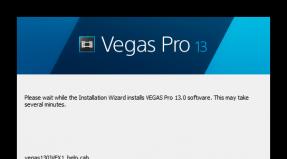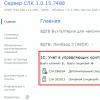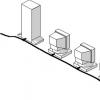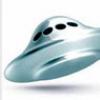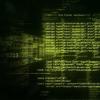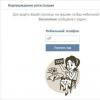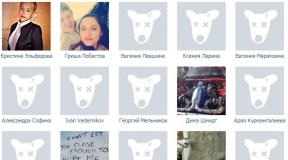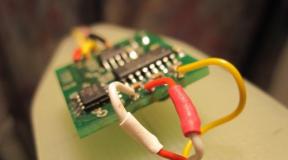Classifier of fixed assets 1s. About interesting things from the world of IT, instructions and reviews. Selecting a classifier for fixed assets
After creating a new database, it is recommended to immediately load the main reference books into it, such as ENAOF(Unified standards for depreciation of fixed assets) and OKOF(All-Russian Classifier of Fixed Assets). These references are located in the configuration update release folder and are called enaof.xml and okof.xml.
ENAOF– unified standards of depreciation charges for full recovery fixed assets. The ENAOF directory is necessary to determine the annual depreciation rate for fixed assets. To automatically substitute the percentage rate, you need to load ENAOF into your database.
OKOF is an all-Russian classifier of fixed assets. In order not to make a mistake when choosing a depreciation group when adding fixed assets in the 1C: Accounting 8.3 program, you need to download the OKOF directory into your database.
Go to the section Directories, then in Settings and choose Setting up actions.
The action panel settings window opens. Here you can select the menu items required to be displayed in the program. From column Available commands on the left, select the items one by one and Download OKOF classifier and button Add move to the right in the column Selected teams.
A subsection should appear Service and it contains the necessary commands, click OK.
In chapter Directories we have a subsection Service with two points Download the ENAOF classifier and To download ENAOF click on Download the ENAOF classifier.
enaof.xml enaof.xml. Select it and click Open.
To appear full list Classifier groups You can select specific groups, but I recommend loading all groups. Select all classifier groups and click Download.
Load the directory in the same way OKOF. Go to the section Directories, then click on Download the OKOF classifier.
In the window that opens, click Open file.
To download we need a file okof.xml, which is located in the templates directory. For 1C: Accounting 8.3 the default configuration template directory will be like this C:\Users\Username\AppData\Roaming\1C\1cv8\tmplts\1c\Accounting. Go to the folder with the latest release of the program and see in it required file okof.xml.
Select it and click Open.
In the window that opens, click Download data and wait for the download to complete. Loading the classifier OKOF takes longer than ENAOF, Therefore, it may seem to you that the computer has frozen, but this is how the boot process occurs, you need to wait. 
Since 2017, the new All-Russian Classification of Fixed Assets OK 013-2014 (SNA 2008) comes into force.
From 01/01/2017, the All-Russian Classifier of Fixed Assets OK 013-94, approved by the Decree of the State Standard of Russia dated December 26, 1994 No. 359, is canceled and the All-Russian Classifier of Fixed Assets OK 013-2014 (SNS 2008), adopted and put into effect by the Order of Rosstandart, is put into effect dated December 12, 2014 No. 2018-st (hereinafter referred to as the new OKOF). Order of Rosstandart dated April 21, 2016 No. 458 approved direct and reverse transition keys between editions of OK 013-94 (hereinafter referred to as the old OKOF) and OK 013-2014 (SNS 2008) All-Russian classifier fixed assets.
Resolution of the Government of the Russian Federation dated July 7, 2016 No. 640 introduced corresponding changes to Decree of the Government of the Russian Federation dated January 1, 2002 No. 1 “On the Classification of fixed assets included in depreciation groups.”
According to OK 013-2014, OKOF is used for the purposes of budgetary (accounting) accounting by public sector organizations in cases provided for by federal standards, unless otherwise established by the authorized bodies of state regulation of accounting. The use of OKOF for the classification of fixed assets is established by the Instructions for the use of the Unified Chart of Accounts, approved by Order of the Ministry of Finance of Russia dated December 1, 2010 No. 157n.
In this regard, starting with versions 1.0.42 edition 1 (BGU1) and 2.0.47 edition 2 (BGU2), respectively, the fixed assets classifier file has been updated in the 1C: Public Institution Accounting 8 delivery okof.xml.
File okof.xml contains both classifiers - OK 013-94 and OK 013-2014. At the same time, OK 013-2014 codes are in compliance with depreciation groups in accordance with Decree of the Government of the Russian Federation dated July 7, 2016 No. 640. After loading it in the directory “ OKOF» both classifiers will be available.
From 01/01/2017, only OK 013-2014 is expected to be included in the delivery (file okof.xml).
According to the explanations of methodologists of the Department of Budget Methodology of the Ministry of Finance of Russia (Letter of the Ministry of Finance of Russia dated December 27, 2016 N 02-07-08_78243), for objects acquired before 01/01/2017, in connection with the change in OKOF, depreciation groups and terms beneficial use don't change. New depreciation groups are applied to fixed assets acquired from 01/01/2017: “The grouping of fixed assets accepted for accounting (budget) accounting from January 1, 2017 should be carried out in accordance with the grouping provided for by the All-Russian Classifier of Fixed Assets OKOF OK 013-2014 ( SNA)) and useful life determined by the provisions of the Government Decree Russian Federation dated January 1, 2002 No. 1 “On the classification of fixed assets included in depreciation groups” (as amended by Decree of the Government of the Russian Federation dated July 7, 2016 No. 640).”
The Department of Tax and Customs Tariff Policy of the Ministry of Finance of Russia has a similar position (letter of the Ministry of Finance of Russia dated November 8, 2016 No. 03-03-RZ/65124):
“The taxpayer has the right to increase the useful life of an object of fixed assets after the date of its commissioning if, after reconstruction, modernization or technical re-equipment of such an object, its useful life has increased. In this case, an increase in the useful life of fixed assets can be carried out within the time limits established for the depreciation group in which such fixed assets were previously included.
Other cases of change in useful life an object of fixed assets previously put into operation (transfer from one depreciation group to another), not provided for by the provisions of the Code.
Taking into account the above, in relation to fixed assets put into operation after 01/01/2017, the Classification of fixed assets should be applied to determine the useful life as amended by Decree of the Government of the Russian Federation dated 07/07/2016 No. 640.
In relation to fixed assets put into operation before 01/01/2017, the useful life determined by the taxpayer when putting them into operation applies.”
To replace OKOF codes in the directory " Fixed assets» processing applied « OKOF Replacement Assistant».
Attention! The operation of replacing OKOF codes in the Fixed Assets directory is irreversible; recoding “in the opposite direction” is not provided!
Before recoding, save an archived copy of the infobase.
The grouping of fixed assets in the new OKOF differs from OK 013-94.
Statistical reporting for 2016, form No. 11 (short) “Information on the availability and movement of fixed assets (funds) of non-profit organizations,” approved. by order of Rosstat dated June 15, 2016 No. 289, compiled according to the old OKOF (OK 013-94).
You should not replace OKOF codes in the directory " Fixed assets» before reporting for 2016 (the deadline for submitting form No. 11 (short) is April 1).
Loading a new OKOF (OK 013-2014)
To download a new OKOF, you should open the directory " All-Russian classifier of fixed assets»
- BGU1 - menu “OS, NMA, NPA – OKOF” of the main menu, interface “Full”;
- BSU 2 - section “Regulatory and reference information”, command of the navigation panel “All-Russian Classifier of Fixed Assets”), or in the section “ Administration"by command" Support and Maintenance» go to section « Other classifiers" and open the hyperlink "".
The new OKOF can be loaded into the directory by pressing the button " Load classifier" on the list form.

The form “ OKOF downloads", in which you should select the file okof.xml. File okof.xml located in the "StateAccounting" configuration template directory. After specifying the path to the file, click the " Download data».

The classifier loading process will begin. When the download is complete, click the " Close" There will be 2 classifiers in the directory:

Indication of new OKOF codes for objects accepted for registration from 01/01/2017
After loading a new OKOF in the documents for accepting the OS for accounting, to indicate the OKOF code to the object, you must first select the appropriate classifier.
When specifying the OKOF code depreciation group And useful life, in months. are filled in automatically if for the specified attribute value OKOF code There is only one depreciation group.

When specifying a code according to the new OKOF, the depreciation group and useful life are indicated in accordance with Decree of the Government of the Russian Federation dated 01.01.2002 No. 1 “On the Classification of fixed assets included in depreciation groups” as amended by Decree of the Government of the Russian Federation dated 07.07.2016 No. 640.
Replacing OKOF codes for fixed assets registered before 01/01/2017
To replace OKOF codes in the directory " Fixed assets» processing applied « OKOF Replacement Assistant"(BGU1 - menu “Service - Utilities” of the main menu, interface “Full”; BGU2 - section “Administration”, action panel command “OKOF Replacement Assistant”), hereinafter – Assistant.
In the Assistant form you should indicate organization, the fixed assets of which require recoding.
With a large range of fixed assets (more than 10,000), the list of processed objects can be limited by specifying the appropriate directory group " Fixed assets».

When you press the button Fill in" in the table Assistant the codes assigned to OS objects (and their names) according to the old OKOF and the corresponding codes according to the new OKOF will be reflected.

To automatically assign a code for the new OKOF, the table of transitional keys “Direct transitional key from OKOF OK 013-94 to OKOF OK 013-2014 (SNS 2008)”, approved by Rosstandart order No. 458 dated April 21, 2016, is used.
A new code is automatically determined only if the code (grouping) in OKOF OK 013-94 and OKOF OK 013-2014 clearly corresponds.
The new code may not be detected automatically for the following reasons:
- If the position in OK 013-94 according to OK 013-2014 is not a fixed asset (for example, 16 1722110 Carpet runners are not a fixed asset according to the new OKOF).
- If for grouping according to OKOF OK 013-94 there is no unambiguous correspondence in OKOF OK 013-2014, that is, objects assigned to the same code according to OK 013-94 must be assigned different codes according to OK 013-2014 (for example, for position 16 3612371 " Working tables" in the table of transitional keys it says: "In accordance with the definition of fixed assets in OKOF OK 013-2014 (SNA 2008) - select from 330.31.01.1")
In the latter case, for each object from such a group, you should indicate a new OKOF code individually.
It should be noted that specific items from the group according to OK 013-94 may belong to another group according to OK 013-2014. For example, if in OKOF (OK 013-94) there was no corresponding position for an object, some accountants assigned code 19 0000000 to objects. For code 19 0009000 “Other material fixed assets not specified in other groupings,” the table of transition keys says: “Not are fixed assets." In this case, for each object from such a group, you should independently determine the codes according to the new OKOF and indicate them to the objects .
To indicate individual codes for group objects, select the corresponding line and click the button " Configure by object».
In the form that opens for object-by-object change of OKOF codes, you should specify a new OKOF code for each object.

For example, for position 16 3612371, according to the table of transition keys, a new code must be selected from the group 330.31.01.1.
In the corresponding line of the form for object-by-object change of OKOF codes Assistant open the directory " OKOF"(step 1), select a new classifier OK 013-2014. For quick search in it, code 330.31.01.1, disable hierarchical viewing of the directory list (step 2) and indicate code 330.31.01.1 in the search (step 3).

We see that the code 330.31.01.1 is a grouping. Select the appropriate code for the OS object (using the “ Choose" or double click).
Also, by copying the new code in the table of transition keys, it can be inserted into the corresponding row of the table of object-by-object change of OKOF codes Assistant, having previously made the line active, and confirm the entry by pressing the " Enter"(Enter).

List of objects with established codes can be printed (button " List»).
After specifying the new codes, click the " OK" forms of object-by-object change of OKOF codes Assistant.
If one new code can be applied to the entire group of objects, it can be set directly in the main form of the Assistant. This code will be applied to all OS objects of the group.
To recode, click the " Replace codes».

A corresponding message is displayed when completed.

Recoding is possible in several stages. When you restart the Assistant or click the “Fill” button again, only groupings according to the old OKOF are included in the table, if the objects included in those groups do not correspond to the new OKOF.
If compliance was not configured for all OKOF groupings (OS objects), in the table Assistant the corresponding lines will remain.

The remaining positions must be matched and codes replaced.
Reclassification of fixed assets
According to OK 013-2014, OKOF is used for the purposes of budgetary (accounting) accounting by public sector organizations in cases provided for by federal standards, unless otherwise established by the authorized bodies of state regulation of accounting.
According to paragraph 53 of the Instructions for the application of the Unified Chart of Accounts for Accounting, approved by Order of the Ministry of Finance of Russia dated December 1, 2010 No. 157n, the grouping of fixed assets is carried out according to property groups provided for in paragraph 37 of these Instructions (real estate of the institution, especially valuable movable property of the institution, other movable property institutions, property - leased items) and types of property corresponding to the subsections of the classification established by OKOF.
The table shows the general correspondence between the groupings of fixed assets in the Unified Chart of Accounts and OKOF as amended by OK 013-94 and OK 013-2014.
|
EPSBU account |
Grouping by OK 013-94 |
Grouping by OK 013-2014 |
|||
|---|---|---|---|---|---|
| number | Name | code | Name | code | Name |
| 101 02 | Non-residential premises | 11 0000000 | building (except residential) | 210.00.00.00.000 | building (except residential) |
| 101 03 | Facilities | 12 0000000 | structures | 220.00.00.00.000 | structures |
| 101 01 | Residential premises | 13 0000000 | dwellings | 100.00.00.00 | residential buildings and premises |
| 101 04 | Machines and equipment | 14 0000000 | cars and equipment | 320.00.00.00.000
330.00.00.00.000 | informational, computer and television communication (ict) equipment Other machines and |
| 101 05 | Transport facilities | 15 0000000 | facilities transport | 310.00.00.00.000 | facilities transport |
| 101 06 | Industrial and economic inventory | 16 0000000 | inventory industrial and economic | 330.00.00.00.000 | other machines and equipment, including economic inventory and others objects |
| 101 07 | Library fund | 19 0001000 | library funds, bodies of scientific technical information, archives, museums and similar institutions | ||
| 101 08 | Other basic facilities | 19 0009010 | capital costs for land improvement (reclamation, drainage, irrigation and other works | 230.00.00.00 | expenses for land improvement |
| 101 08 | Other basic facilities | 17 0000000
19 0000000 | working cattle, productive and tribal (except young animals and livestock for slaughter) Plantings Material basic | 510.00.00.00.000
520.00.00.00 | cultivated animal resources origin, repeatedly giving products Cultivated Resources |
| 400.00.00.00 | weapons systems | ||||
Due to the inconsistencies between the groups in the old and new OKOF, questions arise:
Based on the new OKOF code, will it be necessary to “transfer” an object accepted for accounting (budget) accounting as part of fixed assets before January 1, 2017, to another analytical accounting account?
If the corresponding position in OK 013-94 according to OK 013-2014 is not fixed assets, should the object be written off from fixed assets and taken into account as part of inventories? What records should I use to register the transfer?
These and similar questions are answered in the letter of the Ministry of Finance of Russia dated December 27, 2016 N 02-07-08_78243:
Objects of fixed assets accepted for accounting (budgetary) accounting as part of fixed assets before January 1, 2017 are subject to reflection in accounting (budgetary) accounting in accordance with Instruction 157n with grouping in accordance with OK 013-94 and the useful life of these objects, established taking into account the provisions Decree of the Government of the Russian Federation dated January 1, 2002 No. 1 “On the classification of fixed assets included in depreciation groups” (as amended before 01/01/2017).
If there are no positions in the new OKOF OK 013-2014 codes (SNA 2008) for accounting objects previously included in the groups of material assets, which, according to their criteria, are fixed assets, the commission for the receipt and disposal of assets of the accounting entity can make an independent decision on the classification of these objects to the corresponding group of OKOF OK 013-2014 codes (SNA 2008) and determining their useful lives.
With the introduction of the new OKOF OK 013-2014 (SNA 2008) from January 1, 2017, during the transition between financial years (inter-reporting period), operations to transfer fixed asset balances to new groups, as well as operations to recalculate depreciation, should not be carried out.
Thus, for fixed assets objects accepted for accounting (budgetary) accounting as part of fixed assets before January 1, 2017, OKOF OK 013-2014 (SNA 2008) is applied only for statistical accounting purposes.
As noted above, you should not replace OKOF codes for fixed assets registered before 01/01/2017, before compiling statistical reporting for 2016 (the deadline for submitting form No. 11 (short) is April 1), since the classification of all objects OS for the new OKOF will only be required for the preparation of statistical reporting for 2017. At the same time, we recommend that you carry out a test recoding in copies base in order to identify in advance objects for which a match to the new OKOF will not be automatically found, and make a decision regarding such objects.
What is OKOF? The concept of the All-Russian Classifier of Fixed Assets is familiar to all specialists responsible for accounting for enterprise assets. OKOF was developed for systematic work with funds or, which in this case is the same, fixed assets (Fixed Assets). When compiling it, the standards and principles of accounting, statistical and international accounting were taken into account.
How it works? All enterprises in the course of their activities, one way or another, acquire and use OS. Each acquired unit of property is assigned an individual depreciation group. The period for write-off, that is, the use of fixed assets, depends on the depreciation group code assigned to them. This means that the cost of fixed assets according to OKOF will be written off as expenses within a certain period established by the enterprise.
To classify property assets into certain depreciation groups of fixed assets until 01/01/2017, classifier No. 359, approved by Gosstandart in 1994, was used in accounting. The document was very voluminous, so it was inconvenient to use. It was used for more than 20 years and constantly underwent adjustments. Despite this, the OKOF directory has lost its relevance, and many definitions and characteristics of the OS classification are outdated. Therefore, on January 1, 2017, a new one was introduced into circulation.
Major changes to OKOF
Newest reference system OKOF, which came into force in 2017, has undergone major improvements and changes compared to the previous one. It was developed with a focus on international accounting systems: codes were taken into account during development economic activity enterprises (OKPD), the composition of depreciation groups and the write-off period for fixed assets have changed. The key changes in the new OKOF affected the structure of the codes - instead of nine characters, the codes now consist of twelve, and the composition of seven generalizing groups.
The first 3 digits of OKOF indicate belonging to the main group of fixed assets, and the rest - to OKPD2 according to CPA 2008 (to types of activities).
Basic OKOF codes
- 100/Residential buildings, premises;
- 200/Buildings, except residential, structures;
- 300/Machinery and equipment as well. household equipment and other objects;
- 400/Weapons Systems;
- 500/Cultivated biological resources;
- 600/Costs for transfer of ownership of non-produced assets 700/Intellectual property objects.
Subgroups have been created in each group and each OS is assigned a specific OKOF code.
Transition to the new OKOF in 2017
When commissioning operating systems purchased in 2017, enterprises should definitely use the new OKOF. On the contrary, the principle of accounting for fixed assets acquired before January 1, 2017 should not be changed. Considering depreciation for fixed assets put into operation before 2017, you should adhere to the previous procedure, that is, do not change the previously established write-off period.
For a comfortable transition to the new OKOF within the specified time frame, you should adhere to Rosstandart Order No. 458 of April 21, 2016. The document presents a comparative table of “old” and “new” OS objects and the so-called “transition keys”. All information is presented in the form of a table, with which you can easily select a new encoding for the OS.

The table indicates all positions that are not currently included in fixed assets, i.e. which do not need to be depreciated and transferred to fixed assets.

In the new OKOF, many objects that were previously used as fixed assets and for which depreciation was calculated are no longer classified as such. Actions with such funds are as follows:
- We clarify the correctness of the old OKOF code, valid until 2017;
- We install a new OKOF code using the table of transition keys (Order No. 458);
- We enter information into the OS inventory cards and note that application begins on January 1, 2017. Property put into operation before 2017 does not need to be re-qualified; only the code values need to be changed.
- If, according to the new procedure, the property is classified as inventory, then it should also be transferred. But this, in turn, also applies only to objects that have arrived at the enterprise since the beginning of 2017. OS that were put into operation earlier but meet these criteria should not be transferred to the MPZ.
- We select a new depreciation group for fixed assets registered later than December 31, 2016. The service life of objects delivered before January 1, 2017 does not change. With absence suitable code a value of a higher level should be selected.
Loading the OKOF classifier for 1C 8.3 and 8.2
Since 01/01/2017, enterprises have been using both the “old” and “new” OKOF. The “old” OKOF is already loaded into the 1C program and is used in work, but for all newly introduced operating systems in 2017, OKOF with new terms of use is used. To work correctly with the OS, we need to download and switch to the new OKOF in 1C.
How to load OKOF in 1C
Let's consider loading the OKOF classifier into the 1C program using an example.
To update OKOF in 1C Accounting 8.3, go to “Directories” in the “Fixed Assets” section and find the required document.

If the “OKOF Classifier” directory is not displayed on the screen, you should add it to the menu using the settings (the settings button is presented in the form of gears).
A menu opens with a selection of actions from which we select the navigation setting.

On the navigation panel settings screen, select “OKOF Classifier”, click “Add”, and then click “OK”.


As a result, in the “Directories”, in “OS and Intangible Materials” the desired “OKOF Classifier” will be displayed on the screen.
The program prompts you to open the file for download.

To download the OKOF update file in 1C 8.2, select a document previously downloaded and saved on your computer.

We click on it, and the 1C program begins downloading the file.
A message appears on the screen:

After the message disappears from the screen, you can proceed to loading the file into the program. To do this, click “Download” in the lower right corner.

At the end of the download, “Download Complete” will appear on the screen, and the current “OKOF Classifier” will be automatically displayed.
New OKOF in 1C since 2017 for OS
Let's look at an example of how to select a new OKOF code for the OS.

When filling out the OS card in the program, the OKOF code is filled in in the empty field.
When filling out the OKOF code in the card, you can select information from two different directories: “OKOF Classifier”, valid until 01/01/2017, and “OKOF Classifier”, which came into force after this period.



We select the desired depreciation group in the OKOF 2017 classifier.

We record the data and swipe the OS card.
Updating OKOF in 1C
To update the classifier, let’s go to “Directories” again and select “OKOF Classifier”.

In the Classifier and click “Load classifier”.

An update window with comments opens.

Open the update file that you previously downloaded and saved on your computer.
We hover the cursor over the file, and the download of the OKOF update to 1C 8.3 begins.

The monitor displays OKOF groups that we plan to update. We mark them, click “Download” and wait for the download to complete. The program will display information about the completion of the download on the screen.

OKOF update in 1C is completed.
Chapter Fixed assets and intangible assets – OKOF Classifier:
How to download the OKOF directory in 1C 8.3
If OKOF is not pre-installed in the 1C 8.3 program, then press the button Download OKOF classifier And Open file in the tab that opens Update file:

Important! Don't fill out the directory by button Create manually to save time, even if you are sure that you have chosen the code for the main tool correctly. This may lead to accounting errors!
The file is included in the Accounting 3.0 configuration package and, as a rule, is located in the directory of configuration templates and updates:

Also, the file with the OKOF classifier in 1C 8.3 can be downloaded from the ITS disk, the ITS website. Download the okof.xml file and save it to your computer.
In 1C Accounting 8.3 in the field Data file you must specify the path to the okof.xml file:

Press the button Download data in the lower command bar of the form:

The classifier will be loaded into the 1C 8.3 information database:

Don’t know how to load classifiers into the 1C 8.3 information base? You will find the answer. Or watch our video tutorial:
How to reflect the OKOF code when the OS arrives in 1C 8.3
When receiving fixed assets according to a transfer and acceptance certificate or a delivery note from a supplier, you need to go to the section OS and intangible assets – Receipt of equipment:

By button Create fill in information on received equipment:

In the form of the document we indicate the name of the received equipment, price, quantity, warehouse, number and date of the receipt document, number and date of the invoice. We save and carry out:

In the 1C 8.3 program the following transactions are generated:


Click the Create button. In the form that opens, fill out the bookmark Non-current asset and select from the Nomenclature directory the equipment accepted on account 08.04:


By button Code OKOF in 1C 8.3 we go to the directory OKOF, sequentially open the hierarchical list, open to the final name of the desired OS in the list that opens on the right, select Depreciation group:


Bookmarks BU information and NU information You don’t have to fill it out in this form, or you can fill it out in the document form Acceptance of OS for accounting. Select the selected OS in the document:

Next, fill out the bookmarks Accounting, Tax accounting based on the depreciation method chosen by the organization and the useful life of the asset, and if necessary Depreciation bonus. We navigate and close the document.
From January 1, 2017, the updated tax classification of fixed assets by depreciation groups will also be applied. The approach to determining useful lives in accounting will change.
We invite you to a workshop on switching to a new classifier.
Please rate this article:
In 1C Accounting 8, some directories are not filled out manually by pressing a button Add. As a rule, these are directories with standard data approved at the state level. I have already written about the features of working with such reference books on the site earlier.
Data from such directories is either added individually through selection from a classifier built into the configuration, or downloaded from external file. An example of the first case would be a reference book "Units", and the second - KLADR. Now I will consider another case when it is necessary to load a directory into the database from an external file, namely, loading a classifier of fixed assets (OKOF).
Loading OKOF into 1C Accounting 8.2 is done from the file okof.xml, which by default is located in the directory with 1C Enterprise infobase templates. This file You can also easily download it from the Internet - it’s easy to search and takes up very little space. However, when downloading from the network, you should make sure that it matches your version of the configuration, otherwise an error message will appear when loading.
There was an important part of the article, but without JavaScript it is not visible!
Features of loading OKOF in 1C Accounting 8.2
The OKOF directory is required when specifying the OKOF code for a fixed asset. The depreciation group is also taken from this reference book. The figure below shows OKOF, open in selection mode.

If OKOF is open in selection mode, then it does not have a classifier loading button! To load the OKOF directory into the 1C Accounting 8.2 database, you need to open it “just like that”. To do this you need to go to the menu "Operations / Directories" and find the fixed assets classifier there. In this case, as you can see in the picture below, a button appears in the reference window "Load classifier".


After reading the classifier, its tree structure will appear in the window, in which the sections required for loading are checked with checkboxes. You can check all the boxes or select only the ones you need – there’s not much difference. Next press the button Download at the bottom of the window and wait for the download to finish, after which the download window can be closed.
Comment: in version 8.3, the fund classifier is loaded immediately and the selection window does not appear. This is not a problem, because, unlike the address classifier, OKOF data does not take up much space in the database.
Video tutorial on loading the fixed assets classifier (OKOF) into the 1C database
To download OKOF to new base, you will need the reference file in XML format(okof.xml). You can download it on our website. We give an example for version 1C Accounting 8.2.

Let's sum it up
As you can see, the main problem is that the button for loading the OKOF classifier is missing in its window if it is opened in selection mode, that is, using the button with an ellipsis. You just need to open the classifier from the list of reference books and the button will appear. That's how the program works.
You can familiarize yourself with this and other similar tricks in my distance courses 1C Accounting 8, conducted via Skype. Additionally, you can read about the advantages of the modern method of distance learning via Skype via the Internet.



